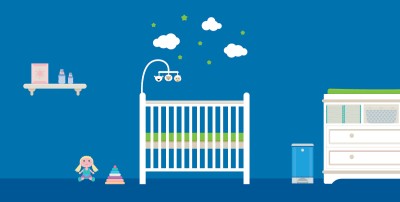
Pregnancy is such an exciting time filled with hope and expectation. It’s also the best time to learn what your baby needs to have a great start in life. Parenting recommendations have changed over the years due to new research and evidence. That’s why it’s so important to stay up to date with the latest practices.
Many new parents and grandparents don’t realize the American Academy of Pediatrics (AAP) recommends that babies sleep exclusively on their back. The recommendation came after years of research and evidence into sudden infant death syndrome (SIDS) and other sleep-related deaths.
Safe sleep throughout baby’s first year
According to AAP, about 3,400 infants die annually in the United States from sleep-related deaths.
To keep your baby safe throughout the first year of life, your baby should:
-
Always be placed on his/her back for sleep time. Babies should never sleep on his/her stomach or side.
-
Sleep alone in an empty crib with no loose objects. NO loose bedding, bumpers, stuffed animals or toys, which may increase the risk for suffocation and entrapment.
-
Sleep on a firm sleep surface. Never put a baby to sleep on an old mattress, waterbed, sofa or cushioned chair. Only use products that meet Consumer Product Safety Commission (CPSC) standards, and have not been recalled for safety hazards.
-
Sleep in the same room, not in the same bed, as the caregiver. AAP recommends room sharing with your baby, (not bed sharing) for at least six months – the first year is preferred.
-
Wear light clothing when sleeping, such as a sleep sack. Also keep room temperatures between 68 and 72 degrees.
-
Not be exposed to tobacco or other smoke. This helps reduce the risk for SIDS.
To learn more about safe sleep, go to healthychildren.org/safesleep for a complete list of recommendations.
Old cribs don’t meet current guidelines
Are you saving a cherished heirloom for your new baby? Most cribs manufactured before 2011 do not meet current safety standards as outlined by the Consumer Product Safety Commission (CPSC). Changes beginning in 2011 do not allow cribs to have sides that drop down (kits to immobilize the sides also are not permitted). Changes also include a variety of improvements like harder woods and anti-loosening hardware. In addition, do not use a crib that has missing parts or has been recalled and not repaired.
To check if your crib complies, call the CPSC at 1-800-638-2772 or visit its website at CPSC.gov.
Earn a crib
Families who are unable to purchase a crib may be eligible to earn a cribette by attending prenatal classes with the help of Lehigh Valley Health Network, Reilly Children’s Hospital and the national Cribs for Kids® program. You can learn more about the program by talking to your doctor, nurse liaison, social services coordinator or outreach worker.
The cribette can be used until your baby reaches 30 pounds or 35-inches in length. It is compact, sturdy and easy to assemble. It also includes wheels and has a convenient travel case as well as an insert that converts into a bassinet for your new baby.
For more information related to newborn care, please visit this page.
